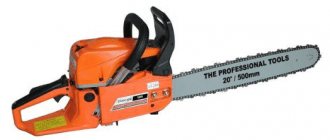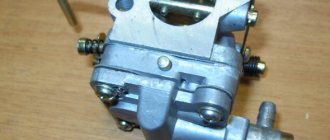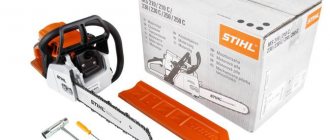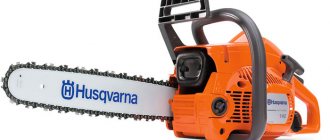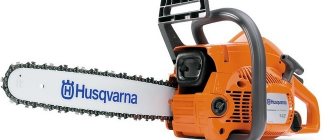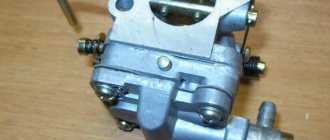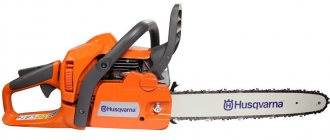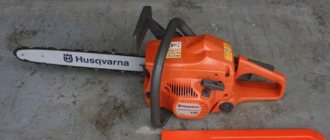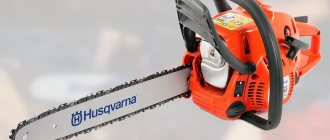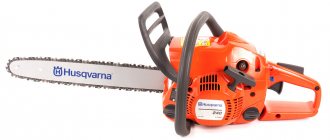Why does the chainsaw stall?
If the chainsaw starts and stalls, the reasons may be different.
An external inspection should be carried out before attempting to repair the instrument. If the saw stalls during operation, you should check the presence of a mixture of oil and gasoline in the tank. If the fuel mixture runs out, the device will not work. In situations where there is still gasoline left, you should evaluate the quality of the tool before turning it off. The appearance of extraneous sounds and the subsequent sudden stop should alert you.
The formation of carbon deposits on the electrodes can also cause difficulties in the operation of the tool. You should carefully inspect the device and clean it if necessary.
When you press the gas
In cases where the chainsaw stalls when you press the gas, you should check the muffler and fuel filter. A possible cause of the problem is a leak in the fuel hoses. In some cases, adding speed helps.
Sometimes checking all the details does not give results, the tool suffocates, chokes when gas is added. If the device stalls when a person presses the gas, it is possible that the fuel supply is insufficient for normal operation. This phenomenon occurs due to a clogged carburetor or filter.
Damage can also occur due to the air filter becoming clogged with dust. When you give gas, the device stops working. You should not fix the problem yourself, since each model has individual characteristics.
The problem may be caused by insufficient or lack of lubrication on the chainsaw chain. If the chain is dry, you should clean the channels through which oil is supplied to the device bus. If the oil leaks, there are cracks and defects in the pipes, they need to be treated with sealant.
Under load
In situations where the device stalls under load, the problem may be with the gas tank or filters. Check the fuel quality and change the filter.
Often the saw does not gain speed due to the fact that the mixture poured into the gas tank has a low octane number. There is not enough power, sufficient heating is not possible, the chainsaw stalls under load.
Often, malfunctions of components lead to the device stalling under load. Hoses, seals, and gaskets should be checked for leaks. If parts are faulty, you can try to repair or replace them.
In cases where the chainsaw starts and immediately stalls, there is not enough fuel, the device does not heat up. The device must be recharged
It is important to use the correct mixture. Different types of fuel are better suited for different models
It is necessary to read the instructions, recommendations, reviews of people for whom the device works normally
It is necessary to read the instructions, recommendations, reviews of people for whom the device works normally.
Idling
In situations where the chainsaw stalls at idle, you need to inspect the condition of the muffler. If the part is dirty, exhaust gases are poorly removed, the engine cannot continue to work and stops.
The saw stalls at idle and in cases where the carburetor is not configured correctly. For beginners, it is better to entrust the repair to specialists, since there is a possibility of incorrect settings, due to which the tool will not be able to work. A tachometer is required to adjust the carburetor.
At high speeds
If the device stalls at high speeds, pay attention to the condition of the gasoline and air filters, the serviceability of the fuel hoses
A dirty air filter can be washed under warm running water.
It is important to thoroughly dry the part before installing it so that water does not damage the serviceability of the tool.
If fluid stops flowing through the fuel hose, it is clogged. You can clean the part or replace it with a new one.
In cases where the saw stalls at high speeds, but the liquid completely flows through the hose, and the air filter is clean and in good working order, look for the cause of the breakdown in the fuel filter. Replace it with a new one or clean it.
In some cases, the problem is hidden in the gasoline pump. When a component wears out, fuel begins to leak through the walls. If this phenomenon is observed, a new pump should be installed.
When tilted
If the saw does not develop speed when tilting, turns off, or stops working, you need to check the fuel level in the tank. If it is not too high, the device in an inclined position is not supplied with sufficient fuel, since the fuel pipe is above the mixture level.
Possible faults
To get any tool working properly, you must first determine the exact cause of the failure. Let's look at the most common situations in which a chainsaw stalls.
Poor quality fuel
For trouble-free operation of the engine, the quality of the fuel used is important. To keep your saw running smoothly, it is important to use the correct fuel. Fill the tank with gasoline with the octane rating recommended by the manufacturer.
Fill the tank with gasoline with the octane rating recommended by the manufacturer.
The second important condition is choosing the right oil. When purchasing, you should give preference to products from brands that produce lubricants with special additives. The saw may stall if the proportions of gasoline and oil are not observed during refueling.
Due to lack of lubrication, the mechanisms jam and the tool stops working.
The saw may stall if the proportions of gasoline and oil are not maintained during refueling. Due to lack of lubrication, the mechanisms jam and the tool stops working.
When mixing, you should use the proportions indicated in the instructions for the saw, and not the data on the oil packaging. The optimal ratio for most tool models is 25 ml of lubricant per 1 liter of gasoline.
For smooth operation of the saw, use AI-92 gasoline and two-stroke oil.
Filters are clogged
In this case, the saw runs idle, but when you press the gas it stalls. Most often this is caused by the use of low-quality gasoline. A clogged filter interferes with the flow of fuel to the engine, so the saw stops under load.
One of the important parts of the tool is the air filter. The performance of a chainsaw depends on its cleanliness and correct choice, which directly depends on the operating conditions of the tool:
- Cotton filter - installed on tools that are used with a saw in the warm season in dry air.
- The HD 2 filter is intended for use of the tool in winter or in dusty conditions (for example, during large-scale logging). Such parts are often equipped with professional tools.
Breather clogged
This small hole on the chainsaw tank is designed to allow air to enter. Depending on the model, it is located in the lid or in one of the walls. A clogged breather creates a vacuum inside the tank, which prevents fuel from entering the carburetor.
Fuel supply interrupted
A broken or damaged pipe is a possible reason why the saw stalls during operation. In this case, the tool starts up, since a small amount of fuel is present in the engine, but refuses to work further.
Storing the saw at sub-zero temperatures will cause the fuel tube to crack. The situation will be corrected only by replacing the part.
Problems with electrical components
Spark plugs are an important element of a chainsaw engine. The tool may stall if carbon deposits accumulate on their surface. Therefore, spark plugs need to be cleaned periodically and changed promptly.
Problems with the power supply can occur if the gap between the ignition coil and the magneto is damaged. This is caused by impacts when operating the saw in difficult conditions. For stable engine operation, the gap should not be more than 0.5 mm.
Expert opinion Dmitry Konstantinovich Levin
The lack of a spark may be due to a clogged fuel filter or depressurization of the tubes. If the spark plugs are wet, it means that during operation of the tool they are filled with gasoline or oil.
Carburetor not adjusted or clogged
Problems with the operation of this unit are indicated by the saw stopping at idle.
The carburetor malfunctions in the following cases:
- clogged jets, nozzles, channels or filters;
- wear of oil seals, cuffs, gaskets;
- incorrect adjustment.
Dirty muffler
The accumulation of carbon deposits in this part leads to loss of power of the tool. The muffler can become clogged if the wrong or low-quality oil is used. Adding too much lubricant to gasoline can also cause clogs.
Poorly lubricated chain
Due to clogging or damage to the oil drive, the tool tire remains dry: the chain jams and the saw stalls during operation. The same problem can arise when using low-quality oil.
Reasons why a chainsaw starts and stalls
Why does a chainsaw start and immediately stall?
Chainsaw
starts and immediately stalls, the reason for this behavior may be hidden in the carburetor. A malfunction of the fuel pump or a malfunction of the main fuel jet may cause this behavior of the saw. The inability of the chainsaw to operate after starting requires a full diagnosis at a service center.
All of the above options for engine malfunction have similar causes, which, depending on their neglect, can have different manifestations. For example, with a slight leak of air into the engine crankcase, its operation will not change much, the engine power will drop slightly, its maximum speed will increase, and it will be able to heat up a little more. At medium stages of air leakage, the engine will stop idling and will become very hot during operation. Strong air leaks will make it impossible for the saw to work, it will start and immediately stall
.
In parallel with the visible manifestations of malfunctions, for example, the inoperability of the chainsaw after starting, processes will take place inside the engine at the time of its incorrect operation that irreversibly lead the saw to the most severe consequences, for example, melting of the piston, jamming of the crankshaft.
Electrical equipment
Malfunctions of the ignition system are determined quite simply by checking the spark plug and adjusting the gap in the contacts. After checking the integrity of the wiring, the causes of the failure should be sought in the operation of the electronic unit.
The absence of a spark at the contacts may be a consequence of a breakdown of the noise suppression resistor located in the body of the spark plug. To check its integrity, simply connect the high-voltage wire to the spark plug directly.
What to do if the chainsaw stalls when you press the gas
One of the most common questions regarding the operation of this device is: why does the chainsaw stall when you press the gas and what needs to be done to solve this problem? In such a situation, you need to do the following:
- check the fuel filter;
- inspect the fuel hoses for leaks;
- check the muffler;
- try to increase the speed a little;
- Check the condition of the rubber seals on the crankshaft.
The chainsaw starts and stalls - the reason
If the chainsaw
starts and stalls during the first attempts to do the job, the reason may be problems with the chain brake or its jamming due to lack of lubrication. In this case, measure the oil level. If the amount of lubricant is sufficient, then the reason may lie in the tube that leads it to the lubrication mechanism.
Another reason could be a carburetor failure. If it only needs adjustment, you can do it yourself according to the instructions. If the carburetor needs cleaning or repair, then you cannot do without the help of professionals.
Another possible cause of this malfunction is a low fuel level in the tank. In this case, the chain saw stalls when tilted, since the remainder of the fuel mixture ends up in the part of the tank opposite to the place where the suction tube is located.
Why does the chainsaw not pick up speed and stalls?
If the chainsaw is unable to gain speed a minute after starting or stalls when the gas trigger is pressed, most likely the carburetor or engine crankcase is leaking. As in the previous case, the problem can be solved by checking for leaks and adjusting the carburetor.
If your chainsaw does not pick up speed and stalls after it has been running normally for about 5 minutes, the cause may be a defective fuel tank breather. The vacuum created in the fuel tank during operation of the tool does not allow the engine to receive the necessary amount of fuel for its normal operation, and for this reason it will be unable to gain speed or stall
. In this case, if you stop the tool, open and close the fuel tank cap and start the chainsaw again, the tool will again work normally for about five minutes, after which it will stop picking up speed or stall.
The reason that the chainsaw does not pick up speed may also be excessive carbon deposits in the muffler, which makes it difficult to release exhaust gases, thereby reducing engine power and speed.
If you want to check the tightness of the crankcase, but do not have a special tool, you can use the following testing method.
Structural components of a chainsaw
All chainsaws are similar in structure, regardless of whether they are made in Europe (ECHO, Stihl, Husqvarna) or at home (Cedar, Urals). The main elements are located inside the body.
Fuel tank and engine, and outside. Starter, handle, part of the saw (bar) with chain. A sharp tug of the cable starts the motor and it is the saw blade. To begin with, we suggest you familiarize yourself with video clips that show how a chainsaw works and how it works:
From time to time, saws develop malfunctions that require disassembly. What can happen to such a simple mechanism as a chainsaw? At least the following:
- Stops starting;
- It starts but soon stops;
- It ceases to function in context;
- Loses strength;
Most problems are related to engine failures (fuel system, exhaust system, ignition, piston part of the cylinder) or failures of other systems and components (clutch, chain brake, tire, lubrication system). Let's look at the most common faults and how to fix them.
The working chainsaw starts with one jerk and does not cut
The chainsaw engine turns off after reaching maximum speed
The power unit stalls at high speeds due to the performance characteristics of the electronic unit not meeting the stated requirements. Failure is more typical for budget chainsaws made in China.
The reason for refusal may be:
- lack of fuel mixture in the float chamber due to valve sticking;
- clogging of the fuel filter or the breather located in the fuel tank cap.
The power unit also stalls at high speeds due to a dirty air intake filter. The same symptoms are typical for a situation where the chainsaw started up in standard mode and stalled during the warm-up stage.
Why does a chainsaw stall when heating up?
The situation when a chainsaw starts up when cold, but may stall while heating up, is familiar to many who own it. The main prerequisites for such saw behavior are the following.
- The ignition module (coil) is faulty. The natural option to find the fault is to check the spark first on a cool engine, and then on a hot one. If there is no spark on a hot engine, then it is worth trying to eliminate the fault by replacing the ignition coil.
Naturally, check the ignition coil using a multimeter or replacing it with a previously working one. Checking the primary and secondary windings with a multimeter is carried out while working in resistance measurement mode. The resistance of the primary winding, the working coil, is one kOhm - the secondary is four kOhms.
Husqvarna.Idle increase.Carburetor repair.carburetor adjustment
Husqvarna chainsaw
555.
- The chainsaw accelerates too slowly;
- The tool does not achieve maximum power, and under load it quickly drops;
- The engine often stalls;
- The chain saw makes a lot of noise when operating;
- The chainsaw releases an uncharacteristic amount of smoke, increasing with each load stage.
As soon as you notice any of the listed deviations, the carburetor of the 435 scythe or its slightly strengthened copy of the Husqvarna 55 saw must be urgently adjusted. If the chainsaw starts sneezing or has trouble starting, then it’s time to adjust the carburetor of the Husqvarna 137 chainsaw with your own hands will be an excellent solution to these problems. Timely maintenance also foreshadows the absence of waste on a complete replacement of spare parts and units of the drive and fuel system of the chainsaw motor. Therefore, if there are difficulties in the operation of the Husqvarna 340 carburetor system and all other lines, the settings will save the chainsaw, the work processes, and the owners’ funds. If necessary, you can order the infusion of mechanisms, replace spare parts, and also buy a line for a trimmer with advice on its independent installation.
An indispensable assistant for each of us
This model has a significant advantage, specifically low weight, which contributes to more convenient operation, and is also quite economical, as the manufacturer has equipped it with an engine (two-stroke) which has a small volume. Unfortunately, despite this kind of functionality, the Husqvarna chainsaw is quite powerful. One of the most successful models is the Husqvarna 137 saw.
As for the characteristics of the chainsaw, its weight is about 4.6 kilograms, despite the fact that this is the “clean” weight of the tool, without the presence of oil, fuel, tires and chain. Of course, when fully equipped, the chainsaw will weigh significantly more than just that, but the undeniable advantage is that thanks to the long tire, which has thirty-eight centimeters, operation becomes easier. It is this feature that makes it possible to produce deeper cuts.
The chainsaw from this manufacturer has a very respectable power, which is about 1.6 kW, which contributes to a significant increase in the level of vibration waves; this is a significant disadvantage when working with this tool. Perhaps the manufacturer for his products thought out how to reduce this kind of vibration and did not supplement the equipment with a so-called anti-vibration mechanism.
Speaking of revolutions, in operating mode their number is 13,000, and in running mode – 3,000.
The tool is controlled by a double-lever design with a built-in starter, which, to be honest, is quite inconvenient, since due to its location it is difficult to reach certain parts during maintenance. Choosing an inexpensive chainsaw for home use is not an easy task. If you decide to go with this model, then you will have to pay a considerable amount for such a chainsaw, since oil is one of the most expensive in the range of products produced by this manufacturer. You can find out the prices for chainsaws made in Russia here.
Read also Vibrating potato digger for Neva walk-behind tractor
The small-sized chainsaw Husqvarna 137 belongs to the category of amateur equipment. The product is light, comfortable and compact. It is popular not only in households, but also among professional lumberjacks. The unit is in demand among builders, rescuers and foresters, as it is convenient for them to work in hard-to-reach places and in cramped conditions.
Husqvarna 128r trimmer does not develop speed
Review: Gas R. Mow the grass without unnecessary gestures? Easily!
Hello, dear Otzovik readers!
In our polar regions there is a widespread joke with the beard: “Our northern summers are short and the snow is light.” Well, the truth is: summer is much later and ends much earlier than in central Russia. Yes, and frosts with falling snow, say, in August, are not uncommon. Therefore, as soon as the temperature becomes stably positive, the vegetation grows rapidly, trying to decompose the seeds as quickly as possible.
For us, the time has come for “haymaking”: just a few days later, overgrown with dandelion, timothy, weeds and other weeds, we must take a helmet and try to make something like a lawn. That was until last year.
Last summer I decided to keep up and buy a trimmer. Electrical parameters are immediately discarded. I was not at all happy about the prospect of lugging around a 30 meter extension cable. For brass triggers, he settled on Huskvarna, known for the quality and reliability of their products.
A trip to stores selling such a product showed that in our region the demand for trimmers is high: there were no models that suited me, I had to wait. So, a week later I became the owner of a Husqvarna 128R
A little about the characteristics. The engine is 2-stroke, with a volume of 28 cm3, a power of 0.8 kW (1.1 l / s). Engine speed. up to 10,000 rpm.
The fuel tank (more precisely, the gas tank) has a volume of 400 ml.
The trimmer motor is equipped with a Zama carburetor. The Smart Start system ensures easy and quick engine starting.
There is a sign attached to the carburetor cover with the sequence of actions when starting a cold engine. for those who are too forgetful.
The muffler is closed with a housing that prevents accidental contact with heated parts.
The chainsaw itself is gaining momentum - how to solve the problem?
This malfunction most often indicates a violation of the operating mode of the fuel and other systems of the chainsaw. There is no single specific cause for this breakdown, since an arbitrary increase in the speed of a running motor can result in the formation of a defect in several different components at once.
The first thing the operator needs to do is inspect the fuel system components. Quite often, a chainsaw engine picks up speed on its own when the fuel supply settings in the standard carburetor are disrupted. In this case, you will need to remove the assembly, disassemble it and wash it with clean gasoline. After it dries, you need to install the carburetor back and make its settings.
Next you need to inspect the condition of the fuel filter. As a result of prolonged use of the chainsaw, it may become damaged. Because of this, the fuel will enter the cylinder unfiltered, with a large amount of impurities and small chips. This can damage the motor and cause it to seize. As a result, the chainsaw will randomly pick up speed immediately after starting its internal combustion engine.
The next step is for the operator to inspect the fuel pipes
They should sit in their seats and, most importantly, there should be no holes in their walls. If they appear, the fuel hose will need to be completely replaced.
Another reason for an arbitrary increase in speed is the jamming of the gas lever. If the operator frequently pressed it while wearing oil-stained gloves, grease particles could seep into the lever and stick to its surface. As a result, the lever itself will begin to stick to the walls of the housing, giving the command to the engine to gain speed. Disassembling and subsequent cleaning of the body and gas lever of the chainsaw will help solve this problem.
Chainsaw operating instructions
The Husqvarna 137 chainsaw, like other models of this brand, is equipped with an inertial automatic chain brake. This part was invented by engineers working at Husqvarna. Nowadays, most manufacturers still produce chainsaws with contact brakes. That is, the brake is activated when interacting with the hand during a reverse impact. In practice, such a contact brake may not work at all. Don’t forget to take care of your engine; to learn how to dilute gasoline with chainsaw oil, read this article.
The autovibration system of this model operates on the principle of “two masses”. The manufacturer does not produce other systems.
Husqvarna 137 is equipped with a high-profile professional chain (like a Stihl chainsaw). This is another difference from chainsaws with low profile chains. Chainsaws with high-profile chains have a forty percent higher chain. This is especially noticeable with large volumes of work. In addition, such chainsaws maintain high performance even when working with contaminated wood.
One of the most common mistakes when starting a Husqvarna 137 is closing the air damper without turning on the ignition.
It turns out that the fuel mixture enters the cylinder. But there is no spark, no ignition occurs. After this, you will have to unscrew the spark plug, wipe it and screw it back in. Therefore, it is worth remembering that all Husqvarna chainsaws have a combined damper, and the ignition in them will be turned on automatically at the moment when the damper lever is pulled out. There shouldn't be any errors.
Chainsaw stalls at high speeds - simple carburetor repair
The carburetor of a tool is precisely the mechanism that most owners are afraid to disassemble on their own. The reason is that this mechanism consists of many small parts, the location of which must be remembered during dismantling work. However, not everything is as scary and difficult as it might seem. To understand how the carburetor relates to the problem of the engine stopping when the speed increases, you need to know its operating principle, described on the website.
The chainsaw stalls when you press the gas due to the carburetor if:
- Damaged membrane
- Clogged filter element (mesh in the carburetor). This malfunction may be encountered by tool owners who do not have a fuel filter or it is simply disconnected from the fuel hose.
- Needle sticking, which may be due to the use of an outdated fuel mixture
- Clogged jet channels or clogged carburetor
- Bending the connecting part that combines the membrane with the needle to supply fuel to the fuel chamber of the carburetor. This part is also called the foot, since under the influence of the membrane on it, the needle moves and the channel opens. During operation, this foot may bend (wear out) or break (if broken, the engine will not start). If the foot is bent, it can be straightened, but this does not guarantee that the problem will recur soon, so it is recommended to replace the part
It is recommended to clean and wash the chainsaw carburetor, as well as replace faulty parts and elements. After this, you can put it back, not forgetting to also replace (if worn) the sealing gasket between the carburetor and the adapter.
https://youtube.com/watch?v=sqwFep0hl2M%3F
If the chainsaw doesn’t start, what should you do?
The main reasons why a chainsaw does not start are discussed above. Moreover, this applies to instruments of different brands: Shtil, Husqvarna, Partner, Makita, Champion and others. Druzhba chainsaws have a different operating principle, but in general, troubleshooting should begin with the ignition system, or rather, inspecting the condition of the spark plug electrodes. If the manipulations carried out do not help to obtain the desired result, then it is necessary to resort to more serious actions. This means you need to do the following:
- Check the serviceability of the carburetor and adjust it
- Measure the compression level of the engine, and then draw the appropriate conclusion about its serviceability
- Checking compression in the crankcase
Checking the compression in the cylinder allows you to assess the condition and serviceability of the CPG
. To measure compression you will need a compression meter. It is screwed into the spark plug hole, after which the starter handle is pulled. The compression gauge shows the corresponding pressure value in the cylinder. This value should be at the level of 8-12 atmospheres.
If the pressure is significantly lower, then this is a direct sign of a malfunction of the device. In case of malfunction, the cylinder-piston group is replaced with a new one. When installing a new CPG, it is necessary to carefully treat all parts with oil so that chips and scuffs do not form when the engine starts.
If there is no compression in the crankcase, the chainsaw will also not start.
The reason for the decrease in pressure in the crankcase is the gasket, or rather its damage. This gasket is located between the cylinder and the crankcase and to ensure its serviceability, the following manipulations should be performed:
- Disconnect the fuel line from the tank
- Place the tube in a container with a prepared mixture of gasoline and oil.
- Start the chainsaw engine
- If the engine starts and fuel is sucked in, this indicates that the gasket is in good condition.
If fuel is not drawn in, then the crankcase gasket needs to be replaced.
The carburetor is the most important and most complex element of a chainsaw.
If all the above steps did not help to obtain a positive result, then this indicates that the carburetor is faulty. The main malfunction of the carburetor is clogging of its channels and jets. Membranes and other elements fail less often. In any case, you will need to disassemble the chainsaw carburetor, clean it and replace failed parts.
As you can see, there are enough reasons why a chainsaw won’t start. To find out what exactly happened in your case, you need to remember the symptoms the day before. Perhaps before the chainsaw stopped starting, there were malfunctions in the engine, a decrease in power and performance, and other breakdowns were also present. Based on these technical symptoms, it is necessary to begin the search. If you don’t know where to start, then diagnostics should be carried out in order, as described in the material.
The main reasons for chainsaw failure
Although all possible breakdowns in certain parts of the chainsaw system have been described, their solution may not be enough. It is necessary to dwell on some aspects of problem solving in more detail.
Checking the fuel mixture and spark plugs
The fuel mixture that is poured into the chainsaw must be pre-prepared. First of all, we must not forget that when producing a fuel mixture, it is necessary to use only high-quality components approved by the operating book. We also must not forget that it is best to drain the fuel before storing the equipment or between seasons when the chainsaw is idle.
Checking spark plugs can be divided into several subsections. First, you need to remove the spark plugs and check their tips for fuel. This can happen from time to time when the chainsaw is started. Most often, this happens to inexperienced users who simply forget to follow the rules of sequence when starting a chainsaw at cold speeds.
Secondly, there may be carbon on the spark plugs, which simply clogs the connection gap. The gap should have a distance of 0.5 to 0.65 mm. Remove carbon deposits using fine-grained sandpaper or a brush with metal hairs.
Checking and cleaning the muffler
It happens that checking absolutely all components from the hose to the spark plugs does not give results and the chainsaw continues to stall when you press the gas. In this case, all that remains is to check the muffler. This piece of equipment is very often the cause of breakdown. The bottom line is that over a long period of use of a chainsaw, a large amount of deposits accumulates in the muffler. In addition, sediment appears if you fill in a low-quality fuel mixture or use the equipment incorrectly.
The first thing you need to do is check the muffler for carbon deposits. To do this, it must be dismantled. First, the nuts are unscrewed, the muffler, plate and reflector are removed. The main thing is not to tear off the studs on the fastenings during dismantling. If carbon deposits are found inside, it means that the muffler needs to be cleaned, and this can be done in two ways.
The easiest way to clean the muffler can be applied to collapsible chainsaws. To do this, you need to do several steps:
- After dismantling the muffler, the entire internal part is treated with a metal brush in order to remove the main layer of carbon deposits.
- After the top part of the sediment has been removed, the inside of the muffler is cleaned with fine-grit sandpaper.
- To improve the cleaning effect, the muffler is treated with a chemical solution, and then dried well and installed back on the chainsaw.
When removing carbon deposits, the main thing is not to use too much force so as not to deform the muffler structure.
The second option is only suitable for models with a non-separable design, and here carbon deposits are quite difficult to remove in all places of the muffler. It is simply physically impossible to reach all parts of the muffler, but before starting the main cleaning, it is recommended to carry out mechanical cleaning at least in those places where the brush can reach.
After this, shot is poured into the muffler, which, when the chainsaw is shaken, removes carbon deposits, but this method is not the most effective. It is best to use special chemicals that are poured into the system and so the equipment costs several hours. After this, the muffler is purged.
Technical characteristics of the Husqvarna 135 chainsaw
According to the manufacturer, Husqvarna 135 has the following technical characteristics:
- cylinder displacement is 40.9 cubic meters. cm, which is quite a lot for a household chainsaw;
- The power of the Husqvarna 135, with this volume and 9000 rpm, is 1.5 kW, which is a rather modest figure for this volume. For example, Champion 137-16 has similar power indicators, but at the same time, its cylinder volume is 37 cm3;
- in the 135 model, a chain of type H37 is used, which has the following characteristics: pitch 3/8, and the width of the seating groove in the tire is 0.05 inches;
- weight 4.4 kg is average among chainsaws intended for non-professional use.
The chainsaw has a two-chamber carburetor from the Husqvarna 440 model. A manual pump (primer) is built into the fuel supply system, which is necessary to facilitate fuel supply in cold start mode.
Primer for fuel pumping
The two-stroke engine is manufactured and operates using patented X-Torq technology, which will be discussed in more detail a little later.
The main advantage of the 135th model is the Air Injection air purification system, which consists of a practical air filter and air distribution and purification technology using a centrifugal system.
It is also worth noting the high quality of plastic parts and the quick-release fastening of the top cylinder cover. A vibration reduction system, which is implemented using rubber-metal shock absorbers (dampers) and is also patented under the name LowVib.
comparison table
| Model | |||||||||
| cm³ | kW | Nm/rpm | V | cm | type | kg | dB(A) | m/s² | RUB |
| 120 Mark II | 38.2 | 1,4 | 2/6300 | 45 | H37 | 4.85 | 113 | 2.1/2.7 | 10990 |
| 130 | 38 | 1.5 | 1.84/8000 | 40 | 4.7 | 116 | 3.72/5.5 | 11890 | |
| 240 | 38,2 | 1.5 | 1.84/8000 | 40 | H37 | 4.7 | 113 | 2.1/2.7 | 12700 |
| 120i | 36 (Li-Ion) | 30 | H38 | 2.95 | 101 | 18990 | |||
| 135 | 40.9 | 1.5 | 2/6300 | 40 | H37 | 4.4 | 114 | 3.9/3.8 | 13990 |
| 135 Mark II | 38 | 1.6 | 1.84/8000 | 40 | S93G | 4.7 | 116 | 3.72/5.5 | 16990 |
| 418EL | 1.7 | ~ 230 | 40 | H37 | 4.7 | 103 | 15890 | ||
| 420EL | 1.7 | ~ 230 | 40 | H37 | 4.7 | 103 | 16990 | ||
| 435 | 40.9 | 1.6 | 2/6300 | 45 | 4.2 | 114 | 3.8/4.2 | 19990 | |
| 440e II | 40.9 | 1.8 | 2.16/6300 | 45 | 4.4 | 114 | 3.8/4.2 | 20490 | |
| 445e II | 45.7 | 2.1 | 2.4/6300 | 50 | SP33G | 5.1 | 114 | 3.1/4.9 | 20990 |
| 450ell | 50.2 | 2.4 | 2.6/7200 | 50 | SP33G | 5.1 | 115 | 3.1/4.9 | 21490 |
| 61 | 61.5 | 2.9 | 3.6/6000 | 70 | 6.2 | 117 | 6.2/6.9 | 30990 | |
| 436 LI | 36 (Li-Ion) | 35 | 2.7 | 106 | 2.2/2.4 | 24490 | |||
| 455e Rancher AT II | 55.5 | 2.6 | 3.2/6600 | 50 | H25 | 6 | 114 | 3.8/6.9 | 32990 |
| 353 | 51.7 | 2.4 | 2.7/6600 | 50 | H25 | 5 | 115 | 3.1/3.2 | 29990 |
| 545 Mark II | 50.1 | 2.7 | 2.95/7200 | 50 | H25 | 5.3 | 116 | 3.6/4.1 | 39990 |
| 555 | 59.8 | 3.1 | 3.51/6100 | 51 | H25 | 5.9 | 118 | 3.2/5.0 | 35990 |
| 365 | 65.1 | 3.4 | 3.9/6600 | 70 | H42 | 6.4 | 114 | 5.7/8.0 | 41990 |
| 365H | 65.1 | 3.4 | 3.9/6600 | 70 | H42 | 6 | 114 | 3.6/3.5 | 63250 |
| 535i XP | 36 (Li-Ion) | 35 | H38 | 2.6 | 106 | 2.5/2.8 | 25490 | ||
| 372 XP | 70.7 | 3.9 | 4.3/6600 | 70 | H42 | 6.3 | 115 | 5.7/8.0 | 44990 |
| 572 XP | 70.6 | 4.3 | 4.5/8200 | 71 | C85 | 6.6 | 120 | 5.0/4.1 | 57990 |
| 395 XP | 94 | 4.9 | 5.9/6000 | 90 | H42 | 7.9 | 115 | 6.5/10.2 | 60990 |
| T435 | 35.2 | 1.5 | 1.57/7500 | 35 | H37 | 3.4 | 114 | 3.6/3.9 | 25990 |
| T540 XPII | 37.7 | 1.8 | 1.83 | 40 | H37 | 3.9 | 116 | 3.5/4.2 | 42390 |
| T535i XP | 36 (Li-Ion) | 35 | H38 | 2.4 | 106 | 2.0/2.4 | 26550 | ||
| 330i | 36 (Li-Ion) | 35 | H38 | 2.7 | 106 | 2.2/2.4 | 24490 |
Device and design features
The main feature of this model is the presence of a two-stroke engine with an X-Torq fuel combustion system. The system reduces fuel consumption by 20% and also reduces emissions of harmful substances by 70%. Like most modern chainsaws, the model has a Smart Start function, which allows you to start the tool in any weather. A fairly powerful engine for its class (more than 2 hp) is capable of operating at maximum load for up to 1 hour.
Separately, it is worth highlighting the presence of the Low Vib system, dampers and special pads, which significantly reduce the level of vibration and reduce the load on the hands.
Possible risks due to uneven tension
Any changes to the saw set (sagging, broken teeth, overvoltage) can lead to problems during operation. Risks of using a tool with sagging:
- decreased productivity when sawing and felling wood;
- the chain gets stuck in the groove and flies off the bar during startup;
- breakage of the headset, damage to the guide sprockets;
- high load on the rotor, reduced tool life;
- sustaining serious injuries during work.
The design and principle of operation of the Husqvarna carburetor
To successfully configure the Husqvarna chainsaw carburetor, you need to know its structure and understand how it works. In fact, everything is not as complicated as it seems at first glance.
The saw carburetor has a built-in fuel pump, which is responsible for transporting the mixture of gasoline and oil, as well as a diaphragm, a needle valve with a rocker arm. Their joint work makes it possible to dose the fuel supply to the main chamber and two dampers.
One of the dampers is designed to regulate the flow of fuel into the cylinder when you press the gas, it is called the throttle, the second is responsible for limiting the flow of air from the air filter to facilitate starting a cold Husqvarna chainsaw. At the moment when the operator shuts off the air supply to the carburetor using the air damper, the fuel mixture becomes leaner and its supply to the cylinder increases, due to which the chainsaw starts much easier than when a cold start is carried out in normal mode.
The operation of the Husqvarna carburetor involves a valve-nozzle, which atomizes fuel and prevents air from entering the main chamber. Often problems with saw operation can be caused by defects in this particular element. For example, if the chainsaw is stored improperly, the valve may stick, the fuel supply will stop, which will make the engine impossible to operate. Also, malfunctions in the operation of the nozzle can cause air to leak into the main fuel chamber of the carburetor. In such cases, adjusting the position of the adjusting screws will not correct the situation; repair or replacement of the unit will be required.
Three adjusting screws installed in the carburetor body are responsible for adjusting the quality and quantity of the mixture, as well as the number of crankshaft revolutions in idle mode:
- screw (L) – regulates the amount of fuel in low and medium speed modes;
- (H) – responsible for traction at high speeds and their number;
- (T) - changes the position of the throttle valve, thereby regulating the amount of fuel mixture entering the cylinder and the operation of the tool engine in idle mode.
X-Torq technology
An innovative development by Husqvarna engineers is X-Torq technology. It is designed to reduce the amount of unburned fuel in the exhaust gases, which is about 30 percent for two-stroke engines. In order to understand how the system works, it is necessary to imagine how the exhaust gas emission process occurs in a conventional two-stroke engine.
And this happens as follows: after the compressed fuel under the piston ignites, the piston moves to the bottom under gas pressure, thus opening the bypass channels and the fuel mixture, which was previously in the engine crankcase, rushes into the cylinder and pushes the exhaust gases into muffler.
Of course, with this method of purging the cylinder from exhaust gases, a certain amount of the finished fuel mixture will enter the muffler and then end up in the atmosphere.
In engines with the X-Torq system, cylinder blowing is organized in a different way. After a fire has occurred in the cylinder, the piston begins to descend and at a certain moment a bypass channel opens, through which clean air, free of fuel impurities, enters the cylinder directly from the air filter.
Next, the piston drops even lower and, at the same time, closing the channel for supplying clean air, opens the supply of the fuel mixture to the cylinder.
As a result of such changes, exhaust gases are squeezed out of the cylinder with clean air and do not contain impurities of unburned fuel. For the same reason, the engine becomes more economical, this is explained by the fact that fuel losses during the operating cycle are reduced.
Video about X-Torq in action
Below is a video that schematically shows how power strokes occur in the engine of the Husqvarna 135 chainsaw with X-Torq technology.
Why does a chainsaw stall while idling?
What to do if the chainsaw stalls at idle
The chainsaw stalls at idle speed: many owners of this tool face this problem. By its design, the saw is a fairly lightweight tool. But there are times when it fails. The main problem in troubleshooting is determining the correct cause of abnormal operation. The main reasons why it stalls, what to do if the chainsaw stalls. Idling. Chainsaw Shtil 180 stalls at idle. Once the cause is identified, eliminating the defect is usually quite simple.
Circuit diagram of a chainsaw.
Probable reasons for failure
The power unit of all chainsaws is a single-cylinder internal combustion engine. Devices of this type are characterized by such malfunctions as violations of intra-cylinder compression, changes in the fuel mixture ratio, incorrect ignition operation, and low-quality fuels and lubricants. The main problems in the operation of the power unit are the following:
- the engine runs stably at minimum speeds, but stalls when the speed increases;
- the start-up occurs normally, but the idle speed is unstable and stalls quickly;
- won't start.
Electronic ignition circuit for a chainsaw.
Abnormal idle operation can be caused by various reasons. They can be divided into several positions:
- reduced filter capacity (gasoline and air);
- abnormal operation of the ignition system:
- the carburetor settings changed spontaneously;
- malfunction of fuel line elements;
- exhaust channels and muffler are clogged;
- defects of the piston, cylinder, valves.
Repairs should begin with an external inspection and checking the presence of fuel in the tank.
Checking and repairing filters
The engine may run rough or stall if there is not enough fuel or air. Causes: clogged air or fuel filter. To check the fuel filter, you need to remove the fuel line hose from the carburetor fitting and direct it into a container. Then press the fuel pump several times. If the fuel is pumped normally, in clearly defined doses, without dirt, then the fuel filter is working properly. If the stream is weak or fuel is not pumped at all, the filter needs to be replaced or, if possible, cleaned.
Clogging of the fuel filter with sawdust is one of the reasons for chainsaw breakdowns.
Scope of use
At first glance at the Husqvarna 135 chainsaw, it becomes clear that it is not intended to solve serious problems, but it can easily cope with work on a personal plot or construction site. Husqvarna 135 has several technical solutions that are aimed at making it easier to use.
The saw is well suited for roofing work, because
It is lightweight and easy to start, which is very important when working at heights. Also, you can use the saw to work in sawmills, where the saw is needed for trimming knots or sawing off branches
Husqvarna 135 chainsaws can handle such simple tasks easily.
It is very noteworthy that this model is popular among those who engage in figured wood carving using a chainsaw.
Carving - the art of carving wood with chain saws
Tools required for work
Before you start setting up the Husqvarna carburetor, you need to make sure you have all the tools that may be useful. To carry out this type of work yourself, you will need:
- a screwdriver for adjusting screws (H) and (L), it can be bought in specialized stores;
- electronic tachometer for determining crankshaft speed readings (with some experience, you can make adjustments by ear);
- Phillips screwdriver for adjusting screw (T);
- compressor with a blow gun for cleaning the saw before work.
A regular slotted screwdriver will not work for adjustment, since the adjusting screws on Husqvarna chainsaws can have different cross-sections. You will have to purchase a special one, this is a feature of repairing Husqvarna chainsaws; they did everything so that the saw could be repaired only in a specialized Husqvarna service center.
Typical faults and repairs of Husqvarna chainsaws
Owners of Husqvarna chainsaws rarely experience breakdowns of their tools. However, if this does happen, then you can try to fix the problem yourself. Let's talk in more detail about how to identify a breakdown and repair a Husqvarna chainsaw without the help of a specialist.
How to adjust the carburetor on a Husqvarna chainsaw?
In case the Husqvarna chainsaw does not start, or it does not develop speed, the reason for this lies in the violation of the factory carburetor settings. To do this, the tool has 3 screws, marked with the letters “H”, “L” and “T”.
To set up a Husqvarna chainsaw, you need to proceed in this order:
- Adjusting the saw's carburetor begins with warming up its engine for 5 minutes. After this, start turning the “L” screw until you hear the maximum speed generated by its motor. Then immediately turn the screw a quarter turn in the opposite direction;
- Then, with one hand, press and hold the throttle trigger for 10 seconds. At the same time, with your second hand, turn the screw “H” a quarter turn to create maximum load on the motor;
- After this, release the gas trigger and start turning the “T” screw in the direction of the clock hand. As soon as the chain begins to rotate along the bar, turn the screw in the opposite direction until the chain stops.
How to remove the clutch on a Husqvarna chainsaw?
- Remove the air filter and unscrew the spark plug. If necessary, wipe the area around the chainsaw spark plug;
- At the next stage, you will need to remove the sprocket from the Husqvarna chainsaw - this will make it possible to carefully inspect the mechanism for blockages;
- The clutch coil is unscrewed in the clockwise direction. Under it there is a pressure washer, which also needs to be removed;
- At the end, the sprocket is replaced and a new clutch is installed. Reassembling the Husqvarna chainsaw is performed in the reverse order.
The first few starts of the chainsaw engine will be accompanied by ringing sounds - this is due to the fact that the drive sprocket will rotate until it finally falls into place.
Oil does not flow to the Husqvarna chainsaw chain - reasons and solution
- First, remove the protective cover and starter spring, after which the chainsaw air filter is dismantled.
- Below it on the right side there is an oil pump, which needs to be inspected for cracks and other damage. If necessary, replace the pump;
- If you notice that the oil hoses have moved away from their base, then they will also need to be replaced with new parts.
After installing new spare parts, you can continue working with the tool. In the future, use only high-quality oil from trusted manufacturers. The correctly selected sharpening angle of the Husqvarna chainsaw chain is also of great importance, since the speed of movement and the intensity of lubrication of the saw element depend on it.
Video
Below is a video review of the Husqvarna 240 chainsaw made by an ordinary user. After watching it, you can find out how to start a chainsaw, the main faults, as well as the author’s personal opinion about this model of saw.
The Husqvarna chainsaw in the 240th modification is very popular among owners of large gardens and adjacent plots. This semi-professional tool stands out for its increased power, improved lubrication system for the saw set and fairly low fuel consumption. The Husqvarna 240 chainsaw differs from market analogues in its improved ergonomics, which allows it to be used in hard-to-reach places without the risk of damage to the tool or injury to the operator.

